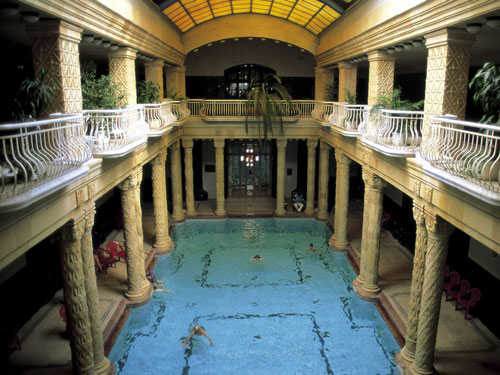The benefits of hot, sulfurous and bicarbonate waters have been known since ancient times, with archeological references that date from times as far back as the Roman civilization. Although the Hispanic Muslims, who occupied the whole Iberian Peninsula until 1492, were fans of water in all of its varieties, this practice was progressively abandoned in the dirty middle ages. For this reason, thermal springs, community pools and spa areas were left in disuse and became ruins. It wasn´t until well into the 19th century when the local Spanish bourgeoisie, copying all those imported from Europe (Baden-Baden in Germany, Lido in Venice and Evian on the French-Swiss border) that people started spending long summers close to the old thermal springs.

That´s how spa resorts started around the country (Lanjarón in Andalucía, in the south, Mondariz and La Toja in Galicia in the north and La Garriga in Catalonia), at the same time as comfortable centres were built that canalized, managed and saved these resources. Towns became luxurious second residencies and they changed the whole urban layout to accommodate this select and distinguished clientele who was looking for resting and relief cures for bone and breathing illnesses. In these exclusive spas, predecessors of today´s modern resorts, was where the aristocratic dame, the casanova-wannabes, the successful businessmen and the artist searching for inspiration came, along with the rheumatic elderly people, for the need to regain strength and experience an intense social life.
These 19th century spas began to decline in the mid-20th century but, in the last decade, a clientele used to urban spas has put them on the map again. And it´s no surprise because the thermal centres (unlike the hammams in the city that use tap water), use waters that are full of minerals that are beneficial for the health. The ones that are by the sea also use algae with known medicinal qualities.
Around Barcelona there are still some spas that are active that were created in the 19th century, conveniently transformed according to the demand of a new international and cosmopolitan clientele. The ones in La Garriga, about half an hour from Barcelona, are the most famous ones. In the town of Tona, Codina even has a special programme for babies. The towns of Caldes de Montbui and Caldes d´Estrac are so strongly-related to water that they have the word ´thermal´ in their name, caldes in Catalan. Due to that interrelation between the places, the artists and the patrons, some exhibitions have been inaugurated recently. And so, the Palau Foundation of Caldes d´Estrac dedicated a room to one of the great universal geniuses, Pablo Picasso, who during a few summers stayed at the residence of the writer Josep Palau i Fabre. The traveller can find information on the subject, which we can´t fit in here, in the following link: http://turismepropbarcelona.cat/ca/termalisme/
In the fisherman´s town of Arenys de Mar, there´s also the spa Balneario Titus. Just like the thermal spas of yesteryear, it´s very well communicated by road with the Catalan Capital and, therefore, the apartments in Barcelona that you´ve booked can be used as a base to explore these century-old baths.

 English
English